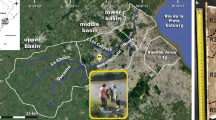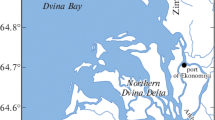Abstract
In this study, the present status of the transboundary wetlands in Central Europe was evaluated using complementary experimental and statistical methods. Detailed characterization of the complex, subsaline/freshwater system in this study is aimed to be the contribution to the global wetland inventory. The distribution and behaviour of major and trace elements in water from the Neusiedler Lake Basin (Austria) were investigated. Two water types were proposed: CaNaHCO3 and CaHCO3. Toxic metals were discussed in comparison with the sediment quality criteria, and Ni was above the value that might cause severe toxic effects. TOC/TN ratio in sediments suggested terrestrial origin of organic matter. Significant variation of trace elements in water was noticed among the sampling sites. Although the Wulka River was anthropogenically influenced, only dissolved Zn, As and U were above world average values. This was the consequence of precipitation and metal adsorption onto suspended particles. Cd, Zn, Mn and Fe were the highest in acidic spring, where low pH maintains metals in a dissolved form. Uranium amounts near closed coalmine exceeded maximum allowed concentration (20 µg L−1). Majority of elements in water and sediment have normal statistical distribution, with a small number of anomalies, thus indicating moderate anthropogenic influence.




Similar content being viewed by others
References
Ágoston-Szabó E, Dinka M (2006) Changes in sediment and sediment interstitial water characteristics in Lake Fertő/Neusiedler See. Opusc Zool 35:3–17
Ágoston-Szabó E, Dinka M (2009) Some characteristics of the sediments of healthy and degraded reed stands at Lake Fertő/Neusiedler See. Opusc Zool 40:5–15
Ascherson P (1865) The drying up of Lake Neusiedl. Miscellen—Zeitschrift für allgemeine Erdkunde—N.F 19:278–281 (in German)
Becker R, Buge H-G, Bremser W, Nehls I (2006) Mineral oil content in sediments and soils: comparability, traceability and a certified reference material for quality assurance. Anal Bioanal Chem 385:645–651
Bilinski H, Kozar S, Plavšić M, Kwokal Ž, Branica M (1991) Trace-metal adsorption on inorganic solid-phases under estuarine conditions. Mar Chem 32:225–233
Boldrin A, Juračić M, Menagazzo V, Rabitti S, Rampazzo G (1992) Sedimentation of riverborne material in a shallow shelf sea: adige River, Adriatic Sea. Mar Geol 103:473–485
Bordowsky OK (1965) Accumulation of organic matter in bottom sediments. Mar Geol 3:33–82
Canada Health (2009) Guidelines for Canadian drinking water quality: guideline technical document—radiological parameters. Radiation Protection Bureau, Healthy Environments and Consumer Safety Branch, Health Canada, Ottawa
Casiot C, Egal M, Bruneel O, Bancon-Montigny C, Cordier MA et al (2009) Hydrological and geochemical controls on metals and arsenic in a Mediterranean river contaminated by acid mine drainage (the Amous river, France); preliminary assessment of impacts on fish (Leuciscus cephalus). Appl Geochem 24:787–799
Cuculić V, Branica M (1996) Trace metals adsorption from seawater onto solid surfaces: analysis by anodic stripping voltammetry. Analyst 121:1127–1131
Cuculić V, Cukrov N, Kwokal Ž, Mlakar M (2009) Natural and anthropogenic sources of Hg, Cd, Pb, Cu and Zn in seawater and sediment of Mljet National Park, Croatia. Estuar Coast Shelf Sci 81:311–320
Cukrov N, Cmuk P, Mlakar M, Omanović D (2008) Spatial distribution of trace metals in the Krka river, Croatia. Ex Self-Purif. Chemos 72:1559–1566
Eitzinger J, Kubu G, Formayer H, Haas P, Gerersdorfer T et al (2009) Impacts of climate change on the water balance of Lake Neusiedl. Final report on behalf of the Office of the Burgenland government-county Schützen am Gebirge. Institute of Meteorology (BOKU-Met) Department of Water—Atmosphere—Environment, University of Agricultural Sciences, Vienna (in German)
Environmental Protection Agency (1998) Method 1664, revision A. n-Hexane extractable material (HEM; oil and grease) and silica gel treated n-hexane extractable material by extraction and gravimetry. EPA-821-R-98-002. US Environmental Protection Agency, Washington, DC
Finlayson CM (2003) The challenge of integrating wetland inventory, assessment and monitoring. Freshw Ecosyst 13:281–286
Finlayson CM, Davidson NC, Spiers AG, Stevenson NJ (1999) Global wetland inventory—current status and future priorities. Mar Freshw Res 50:717–727
Frančišković-Bilinski S, Cuculić V, Bilinski H, Häusler H, Stadler P (2013) Geochemical and stable isotopic variability within two rivers rising under the same mountain, but belonging to two distant watersheds. Chemie der Erde-Geochem 73:293–308
Gaillardet J, Viers J, Dupre B (2003) Trace elements in river waters. In: Holland HD, Turekian KK (eds) Treatise on geochemistry: surface and ground water, weathering, and soils. Elsevier, Amsterdam, pp 225–272
Guagliardi I, Apollaro C, Scarciglia F, De Rosa R (2013) Influence of particle-size on geochemical distribution of stream sediments in the Lese river catchment, southern Italy. Biotechnol Agron Soc Environ 17(1):43–55
Gulia L, Guidi M, Bonadonna FP, Macera P (2004) A preliminary geochemical study of two cores from Massaciuccoli eutrophic lake, Northern Tuscany, and paleoclimatic implications. Atti Soc Tosc Sci Nat Mem Serie A 109:97–102
Hagras MA (2013) Water quality assessment and hydrochemical characteristics of groundwater in Punjab, Pakistan. Int J Res Rev Appl Sci 16:254–262
Häusler H (1992) Research report 16: water resources study for the lake neusiedl with the help of geophysics and geochemistry report of the research project in the framework of the agreement on scientific and technological cooperation between Austria and Hungary. Technical University Vienna (in German)
Häusler H, Frank C, Figdor H, Lenhardt W (2007) Geological map of the Republic of Austria 1:50,000—Notes to the sheets of 79 Neusiedl am See, 80 Ungarisch-Altenburg and 109 Pamhagen. Geological Survey of Austria, Vienna (in German)
Häusler H, Müllegger C, Körner W, Ottner F, Prohaska T, et al (2014) A new hydrogeological model of charging shallow and deep aquifers in the Lake Neusiedl—Seewinkel region (Northern Burgenland, Austria). In: Reichart G-J (ed) European Geosciences Union, Geophysical Research Abstracts, vol 16, Vienna, April 2014, p 3296. European Geosciences Union, Vienna
Horowitz AJ (1997) Some thoughts on problems associated with various sampling media used for environmental monitoring. Analyst 122:1193–1200
Jayaprakash M, Nagarajan R, Velmurugan PM, Sathiyamoorthy J, Krishnamurthy RR et al (2012) Assessment of trace metal contamination in a historical freshwater canal (Buckingham Canal), Chennai, India. Environ Monit Assess 184:7407–7424
Jianfei Y, Xumei M, Yanxin W, Zhide D, Leihui H (2014) Geochemistry of rare-earth elements in shallow groundwater, northeastern Guangdong province, China. Chin J Geochem 33:53–64
Jirsa F, Gruber M, Stojanovic A, Odour Omondi S, Mader D et al (2013) Major and trace element geochemistry of lake Bogoria and lake Nakuru, Kenya, during extreme draught. Chemie der Erde-Geochem 73:275–282
Kim AG, Kazonich G, Dahlberg M (2003) Relative solubility of cations in class F fly ash. Environ Sci Technol 37:4507–4511
Kogelbauer I, Loiskandl W (2015) Characterization of sediment layer composition in a shallow lake: from open water zones to reed belt areas. Hydrol Earth Syst Sci 19:1427–1438
Krachler R (1992) Contributions to chemistry and water balance of the lakes of the Burgenland side of the lake Seewinkels. Ph.D. thesis, University of Vienna
Last MW, Ginn FM (2005) Saline systems of the great plains of Western Canada: an overview of the limnogeology and paleolimnology. Saline Systems 1, 10, published online DOI: 10.1186/1746-1448-1-10
Lenoble V, Omanović D, Garnier C, Mounier S, Đonlagić N et al (2013) Distribution and chemical speciation of arsenic and heavy metals in highly contaminated waters used for health care purposes (Srebrenica, Bosnia and Herzegovina). Sci Total Environ 443:420–428
Manoj K, Ghosh S, Padhy PK (2013) Characterization and classification of hydrochemistry using multivariate graphical and hydrostatistical techniques. Res J Chem Sci 3:32–42
Matić N, Maldini K, Cuculić V, Frančišković-Bilinski S (2012) Investigations of karstic springs of the Biokovo Mt. from the Dinaric karst of Croatia. Chemie der Erde-Geochem 72:179–190
Matić N, Miklavčić I, Maldini K, Tomas D, Cuculić V et al (2013) Geochemical and isotopic characteristics of karstic springs in coastal mountains (Southern Croatia). J Geochem Res 132:90–110
Meyers PA (1997) Organic geochemical proxies of paleoceanographic, paleolimnologic, and paleoclimatic processes. Org Geochem 27:213–250
Parnachev VP, Degermendzhy AG (2002) Geographical, geological and hydrochemical distribution of saline lakes in Khakasia, Southern Siberia. Aquat Ecol 36:107–122
Piller WE, Harzhauser M (2005) The myth of the brackish Sarmatian sea. Terra Nova 17:450–455
Powder Diffraction File (2004) Database sets 1–54, International Centre for Diffraction Data (ICDD). Newtown Square, Pennsylvania
Sampei Y, Matsumoto E (2001) C/N ratios in a sediment core from Nakaumi Lagoon, southwest Japan—usefulness as an organic source indicator. Geochem J 35:189–205
SMSP and FALCONBRIDGE NC SAS (2005) Koniambo project, environmental and social impact assessment, Chapter 4 Mine, 4.2–7 Quality criteria for freshwater sediment
State Archives of Eisenstadt (1963) General topography of the state Burgenland. Eisenstadt (in German)
Stojanovic A, Kogelnig D, Mitteregger B, Mader D, Jirsa F et al (2009) Major and trace element geochemistry of superficial sediments and suspended particulate matter of shallow saline lakes in Eastern Austria. Chemie der Erde-Geochem 69:223–234
Todd DK, Mays LW (2005) Groundwater hydrology, 3rd edn. Wiley, New York
Tukey JW (1977) Exploratory data analysis. Addison-Wesley, ISBN 0-201-07616-0. OCLC 3058187
Tupas LM, Popp BN, Karl DM (1994) Dissolved organic carbon in oligotrophic waters: experiments on sample preservation, storage and analysis. Mar Chem 45:207–216
Ujević M, Duić Z, Casiot C, Sipos L, Santo V et al (2010) Occurrence and geochemistry of arsenic in the groundwater of Eastern Croatia. Appl Geochem 25:1017–1029
Von Eynatten H, Tolosana-Delgado R (2011) Geochemistry versus grain-size relations of sediments in the light of comminution, chemical alteration, and contrasting source rocks. In: Proceedings of the 4th International Workshop on Compositional Data Analysis
Acknowledgments
The research was supported by the bilateral project between Croatia and Austria (2010–2011): “Hydrogeological investigations of the upper flow of the Kupa River and its tributaries” (principal investigators: Dr. Stanislav Frančišković-Bilinski, Ruđer Bošković Institute and Prof. Dr. Thilo Hofmann, University of Vienna) financed by the Croatian Ministry of Science, Education and Sports and the Austrian Agency for International Mobility and Cooperation in Education, Science and Research (OeAD). Special thanks go to Univ. Prof. Dr. Hermann Häusler from the Department for Environmental Geosciences at the Faculty of Earth Sciences, Geography and Astronomy, University of Vienna and MSc. Philipp Stadler from the Centre for Water Resource Systems at the Vienna University of Technology, Austria for their generous and professional support during sampling campaigns. Thanks also go to Mrs. Tatjana Jauk, a professional linguist, who edited English language of the manuscript.
Author information
Authors and Affiliations
Corresponding author
Rights and permissions
About this article
Cite this article
Cuculić, V., Frančišković-Bilinski, S., Bilinski, H. et al. Multi-methodological approach to evaluate trace elements and major components in wetland system with subsaline and freshwater characteristics. Environ Earth Sci 75, 1351 (2016). https://doi.org/10.1007/s12665-016-6156-6
Received:
Accepted:
Published:
DOI: https://doi.org/10.1007/s12665-016-6156-6




